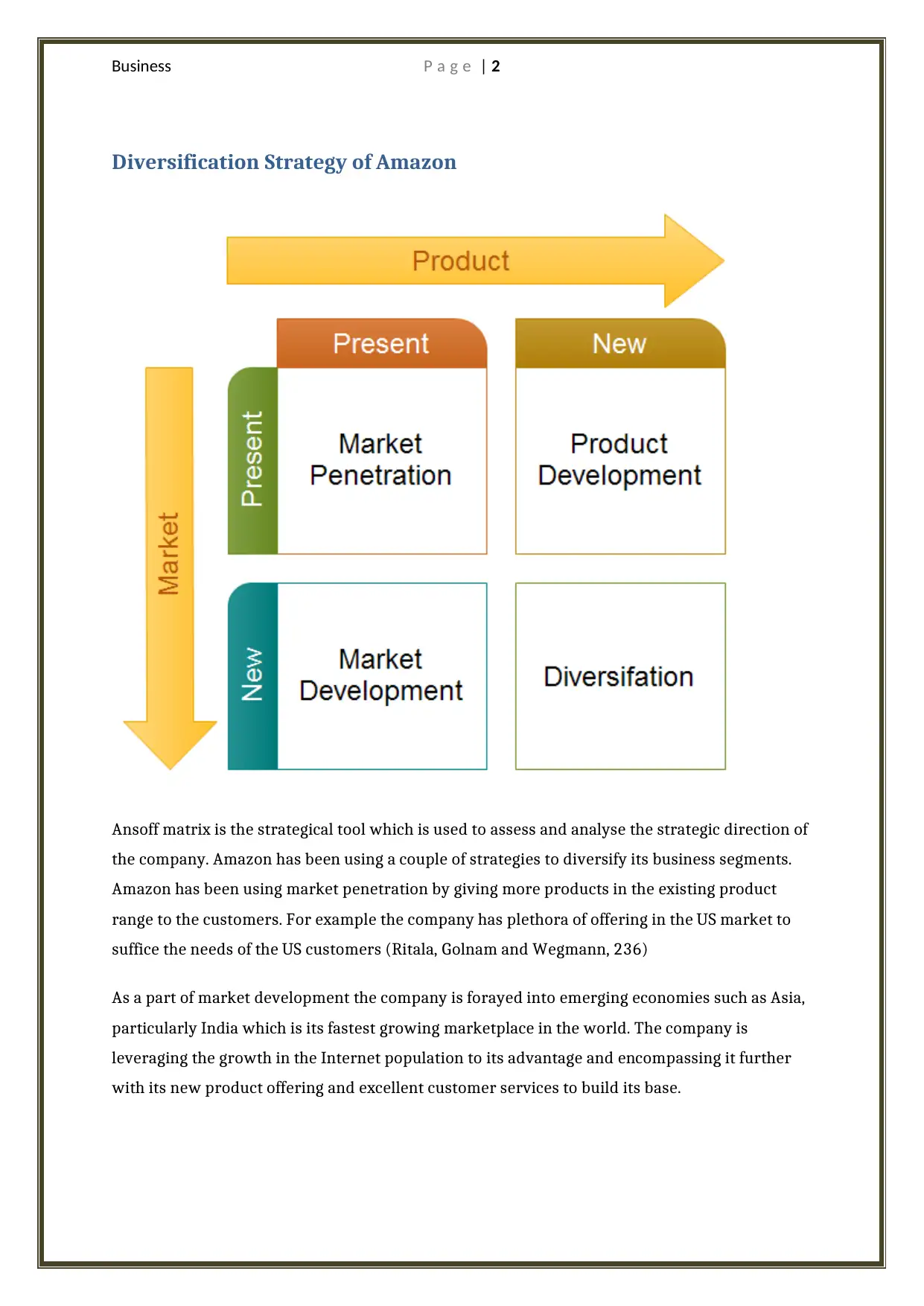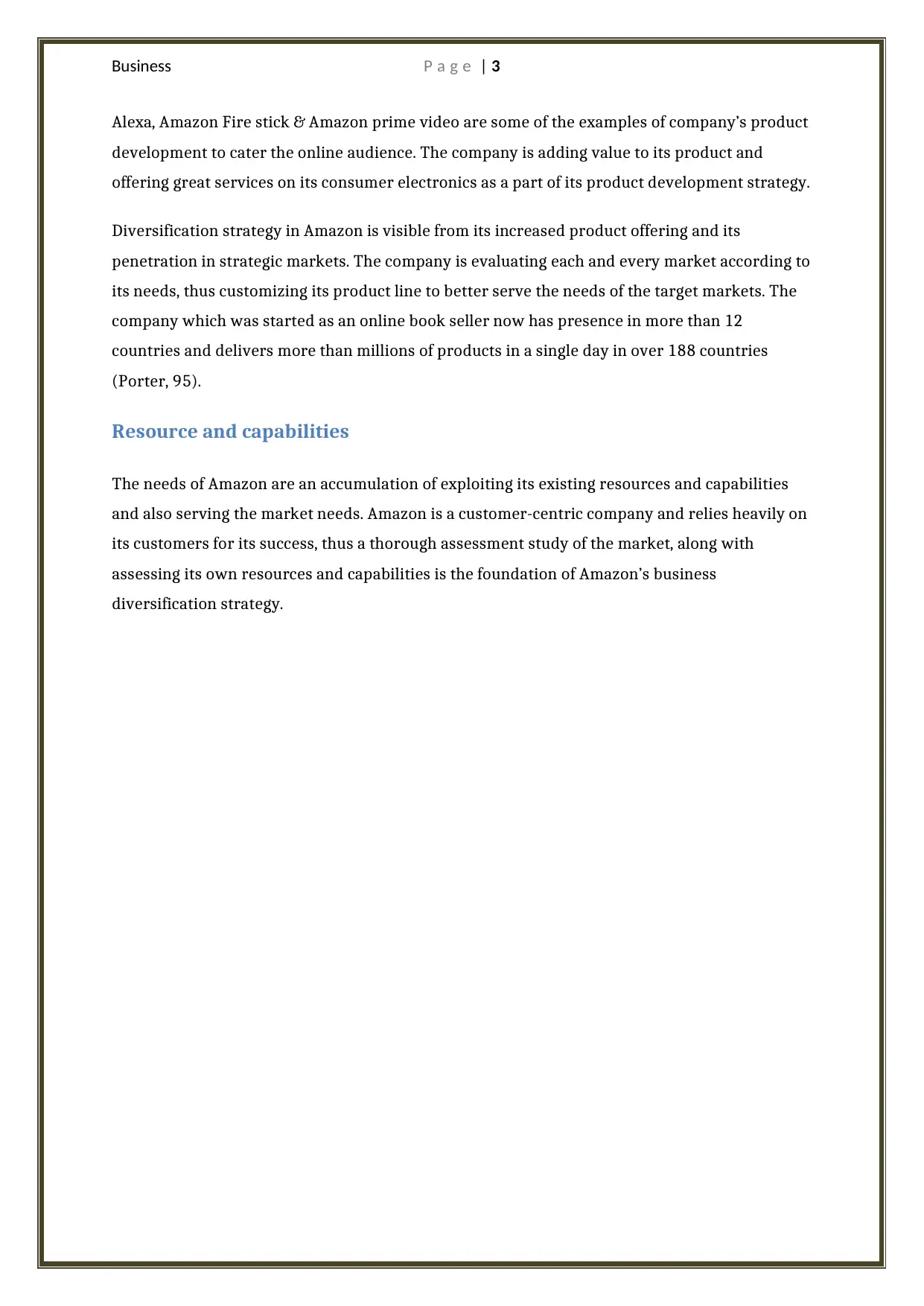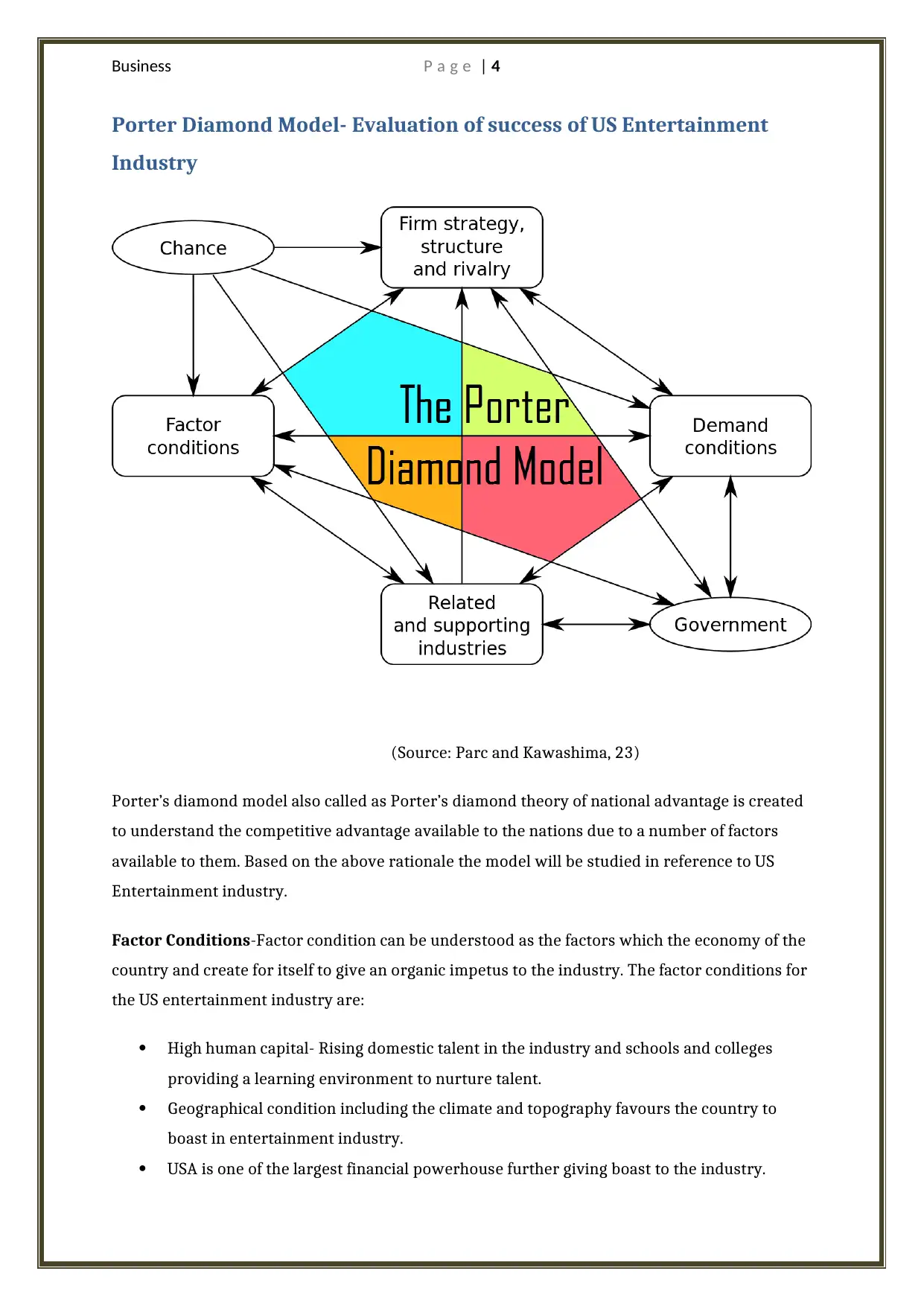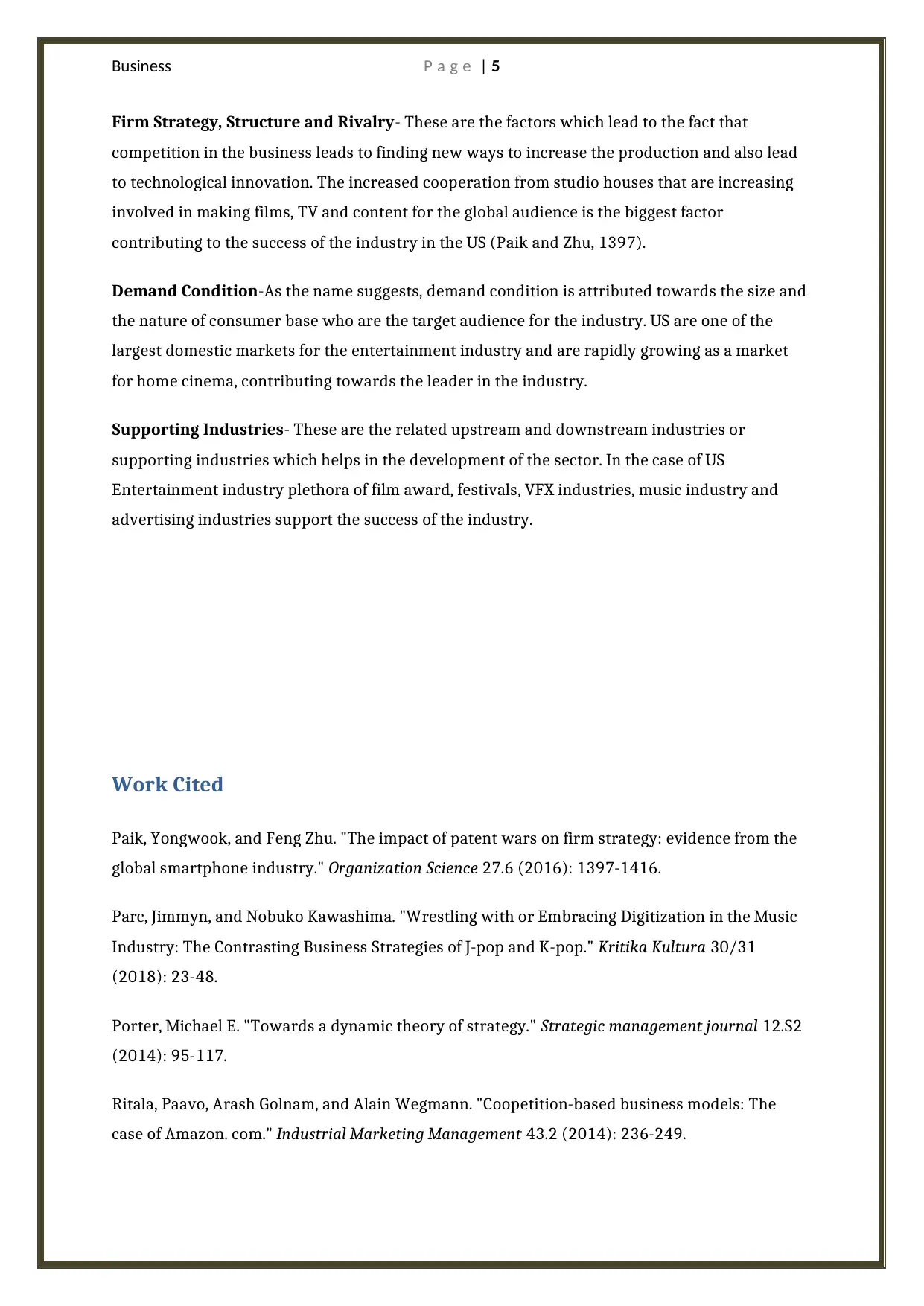Amazon's Diversification Strategy: An In-depth Business Analysis
VerifiedAdded on 2023/06/11
|7
|889
|140
Report
AI Summary
This report provides an analysis of Amazon's diversification strategy, utilizing tools such as the Ansoff matrix to assess market penetration, market development, and product development. It highlights Amazon's expansion from an online bookstore to a global presence in over 188 countries, delivering millions of products daily. The report also examines Amazon's resource and capability accumulation, emphasizing its customer-centric approach and thorough market assessment. Furthermore, it evaluates the success of the US Entertainment Industry using Porter's Diamond Model, considering factors like human capital, geographical conditions, firm strategy, demand conditions, and supporting industries. The analysis covers various aspects, including rising domestic talent, financial power, studio cooperation, consumer base size, and the role of film awards and VFX industries in supporting the sector's success.

Running Head: Business
AMazon
Business
AMazon
Business
Paraphrase This Document
Need a fresh take? Get an instant paraphrase of this document with our AI Paraphraser

Business P a g e | 1
Table of Content
Diversification Strategy of Amazon.......................................................................................................................... 2
Resource and capabilities........................................................................................................................................ 3
Porter Diamond Model- Evaluation of success of US Entertainment Industry.......................................3
Work Cited.......................................................................................................................................................................... 5
Table of Content
Diversification Strategy of Amazon.......................................................................................................................... 2
Resource and capabilities........................................................................................................................................ 3
Porter Diamond Model- Evaluation of success of US Entertainment Industry.......................................3
Work Cited.......................................................................................................................................................................... 5

Business P a g e | 2
Diversification Strategy of Amazon
Ansoff matrix is the strategical tool which is used to assess and analyse the strategic direction of
the company. Amazon has been using a couple of strategies to diversify its business segments.
Amazon has been using market penetration by giving more products in the existing product
range to the customers. For example the company has plethora of offering in the US market to
suffice the needs of the US customers (Ritala, Golnam and Wegmann, 236)
As a part of market development the company is forayed into emerging economies such as Asia,
particularly India which is its fastest growing marketplace in the world. The company is
leveraging the growth in the Internet population to its advantage and encompassing it further
with its new product offering and excellent customer services to build its base.
Diversification Strategy of Amazon
Ansoff matrix is the strategical tool which is used to assess and analyse the strategic direction of
the company. Amazon has been using a couple of strategies to diversify its business segments.
Amazon has been using market penetration by giving more products in the existing product
range to the customers. For example the company has plethora of offering in the US market to
suffice the needs of the US customers (Ritala, Golnam and Wegmann, 236)
As a part of market development the company is forayed into emerging economies such as Asia,
particularly India which is its fastest growing marketplace in the world. The company is
leveraging the growth in the Internet population to its advantage and encompassing it further
with its new product offering and excellent customer services to build its base.
⊘ This is a preview!⊘
Do you want full access?
Subscribe today to unlock all pages.

Trusted by 1+ million students worldwide

Business P a g e | 3
Alexa, Amazon Fire stick & Amazon prime video are some of the examples of company’s product
development to cater the online audience. The company is adding value to its product and
offering great services on its consumer electronics as a part of its product development strategy.
Diversification strategy in Amazon is visible from its increased product offering and its
penetration in strategic markets. The company is evaluating each and every market according to
its needs, thus customizing its product line to better serve the needs of the target markets. The
company which was started as an online book seller now has presence in more than 12
countries and delivers more than millions of products in a single day in over 188 countries
(Porter, 95).
Resource and capabilities
The needs of Amazon are an accumulation of exploiting its existing resources and capabilities
and also serving the market needs. Amazon is a customer-centric company and relies heavily on
its customers for its success, thus a thorough assessment study of the market, along with
assessing its own resources and capabilities is the foundation of Amazon’s business
diversification strategy.
Alexa, Amazon Fire stick & Amazon prime video are some of the examples of company’s product
development to cater the online audience. The company is adding value to its product and
offering great services on its consumer electronics as a part of its product development strategy.
Diversification strategy in Amazon is visible from its increased product offering and its
penetration in strategic markets. The company is evaluating each and every market according to
its needs, thus customizing its product line to better serve the needs of the target markets. The
company which was started as an online book seller now has presence in more than 12
countries and delivers more than millions of products in a single day in over 188 countries
(Porter, 95).
Resource and capabilities
The needs of Amazon are an accumulation of exploiting its existing resources and capabilities
and also serving the market needs. Amazon is a customer-centric company and relies heavily on
its customers for its success, thus a thorough assessment study of the market, along with
assessing its own resources and capabilities is the foundation of Amazon’s business
diversification strategy.
Paraphrase This Document
Need a fresh take? Get an instant paraphrase of this document with our AI Paraphraser

Business P a g e | 4
Porter Diamond Model- Evaluation of success of US Entertainment
Industry
(Source: Parc and Kawashima, 23)
Porter’s diamond model also called as Porter’s diamond theory of national advantage is created
to understand the competitive advantage available to the nations due to a number of factors
available to them. Based on the above rationale the model will be studied in reference to US
Entertainment industry.
Factor Conditions-Factor condition can be understood as the factors which the economy of the
country and create for itself to give an organic impetus to the industry. The factor conditions for
the US entertainment industry are:
High human capital- Rising domestic talent in the industry and schools and colleges
providing a learning environment to nurture talent.
Geographical condition including the climate and topography favours the country to
boast in entertainment industry.
USA is one of the largest financial powerhouse further giving boast to the industry.
Porter Diamond Model- Evaluation of success of US Entertainment
Industry
(Source: Parc and Kawashima, 23)
Porter’s diamond model also called as Porter’s diamond theory of national advantage is created
to understand the competitive advantage available to the nations due to a number of factors
available to them. Based on the above rationale the model will be studied in reference to US
Entertainment industry.
Factor Conditions-Factor condition can be understood as the factors which the economy of the
country and create for itself to give an organic impetus to the industry. The factor conditions for
the US entertainment industry are:
High human capital- Rising domestic talent in the industry and schools and colleges
providing a learning environment to nurture talent.
Geographical condition including the climate and topography favours the country to
boast in entertainment industry.
USA is one of the largest financial powerhouse further giving boast to the industry.

Business P a g e | 5
Firm Strategy, Structure and Rivalry- These are the factors which lead to the fact that
competition in the business leads to finding new ways to increase the production and also lead
to technological innovation. The increased cooperation from studio houses that are increasing
involved in making films, TV and content for the global audience is the biggest factor
contributing to the success of the industry in the US (Paik and Zhu, 1397).
Demand Condition-As the name suggests, demand condition is attributed towards the size and
the nature of consumer base who are the target audience for the industry. US are one of the
largest domestic markets for the entertainment industry and are rapidly growing as a market
for home cinema, contributing towards the leader in the industry.
Supporting Industries- These are the related upstream and downstream industries or
supporting industries which helps in the development of the sector. In the case of US
Entertainment industry plethora of film award, festivals, VFX industries, music industry and
advertising industries support the success of the industry.
Work Cited
Paik, Yongwook, and Feng Zhu. "The impact of patent wars on firm strategy: evidence from the
global smartphone industry." Organization Science 27.6 (2016): 1397-1416.
Parc, Jimmyn, and Nobuko Kawashima. "Wrestling with or Embracing Digitization in the Music
Industry: The Contrasting Business Strategies of J-pop and K-pop." Kritika Kultura 30/31
(2018): 23-48.
Porter, Michael E. "Towards a dynamic theory of strategy." Strategic management journal 12.S2
(2014): 95-117.
Ritala, Paavo, Arash Golnam, and Alain Wegmann. "Coopetition-based business models: The
case of Amazon. com." Industrial Marketing Management 43.2 (2014): 236-249.
Firm Strategy, Structure and Rivalry- These are the factors which lead to the fact that
competition in the business leads to finding new ways to increase the production and also lead
to technological innovation. The increased cooperation from studio houses that are increasing
involved in making films, TV and content for the global audience is the biggest factor
contributing to the success of the industry in the US (Paik and Zhu, 1397).
Demand Condition-As the name suggests, demand condition is attributed towards the size and
the nature of consumer base who are the target audience for the industry. US are one of the
largest domestic markets for the entertainment industry and are rapidly growing as a market
for home cinema, contributing towards the leader in the industry.
Supporting Industries- These are the related upstream and downstream industries or
supporting industries which helps in the development of the sector. In the case of US
Entertainment industry plethora of film award, festivals, VFX industries, music industry and
advertising industries support the success of the industry.
Work Cited
Paik, Yongwook, and Feng Zhu. "The impact of patent wars on firm strategy: evidence from the
global smartphone industry." Organization Science 27.6 (2016): 1397-1416.
Parc, Jimmyn, and Nobuko Kawashima. "Wrestling with or Embracing Digitization in the Music
Industry: The Contrasting Business Strategies of J-pop and K-pop." Kritika Kultura 30/31
(2018): 23-48.
Porter, Michael E. "Towards a dynamic theory of strategy." Strategic management journal 12.S2
(2014): 95-117.
Ritala, Paavo, Arash Golnam, and Alain Wegmann. "Coopetition-based business models: The
case of Amazon. com." Industrial Marketing Management 43.2 (2014): 236-249.
⊘ This is a preview!⊘
Do you want full access?
Subscribe today to unlock all pages.

Trusted by 1+ million students worldwide

Business P a g e | 6
1 out of 7
Related Documents
Your All-in-One AI-Powered Toolkit for Academic Success.
+13062052269
info@desklib.com
Available 24*7 on WhatsApp / Email
![[object Object]](/_next/static/media/star-bottom.7253800d.svg)
Unlock your academic potential
Copyright © 2020–2025 A2Z Services. All Rights Reserved. Developed and managed by ZUCOL.





